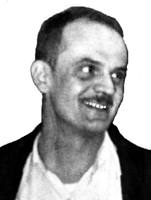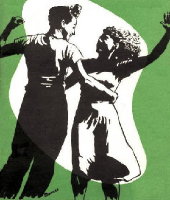
|
The Society of Folk Dance Historians (SFDH)
A Lil' History on Folk Dancin'
[
Home |
About |
Encyclopedia | CLICK AN IMAGE TO ENLARGE |

|
 Folk Dances have been part of the American life since its earliest days. The first forms took place within half a century after the Pilgrims landed at Plymouth Rock. Strangely though, it was in the South, not New England, particularly in the Colonies of Virginia and Carolina, that Folk Dances took root. In the South, during the late 1600s, life was warm and peaceful. The crops, especially tobacco, were plentiful and made many colonists wealthy. They soon assumed the same sort of social life that they had known in England. They lived a wealthy, cultured life and by the early 1700s their primary forms of amusement were fox hunts, dining, and dancing. Their dances were held in splendid ballrooms of the Pre-Georgian Era on polished floors and with small musical orchestras of European style. The ladies dressed for these events in rich brocades or velvets and their escorts wore square-cut knee-length coats, decorated with brass or silver buttons, broadcloth knee breetches, and silk stockings.
Folk Dances have been part of the American life since its earliest days. The first forms took place within half a century after the Pilgrims landed at Plymouth Rock. Strangely though, it was in the South, not New England, particularly in the Colonies of Virginia and Carolina, that Folk Dances took root. In the South, during the late 1600s, life was warm and peaceful. The crops, especially tobacco, were plentiful and made many colonists wealthy. They soon assumed the same sort of social life that they had known in England. They lived a wealthy, cultured life and by the early 1700s their primary forms of amusement were fox hunts, dining, and dancing. Their dances were held in splendid ballrooms of the Pre-Georgian Era on polished floors and with small musical orchestras of European style. The ladies dressed for these events in rich brocades or velvets and their escorts wore square-cut knee-length coats, decorated with brass or silver buttons, broadcloth knee breetches, and silk stockings.
Their dances, like their costumes, were much the same as those in England and France at the same time. There were gavottes, minuets, and other open-work court dances. And, although these dances had a certain remote dignity and charm, the dancers were restricted by the precise, stiff patterns and danced in a wooden, puppet-like manner.
Soon, however, these social and folk dances began to take on color and speed. America said, "These dances are too slow; let's move!" And they did. America loosened up and dropped the stiff precise European ways and "ran" them, so that it took a strong constitution to dance.
Another distinctively native characteristic that America added to its Folk Dance was "Calling." They called out the steps to each dance, describing them in verse that varied from one community to another. Maine and California had the same dances but they were called in entirely different verses. Local variations were added to the dance itself. But the feature of "Calling" country dances is American — no other country has it. Today, nearly all groups and figure dancing is referred to as "Square Dancing." In reality, this is incorrect because they include round, circle, square, running longways, and contra dances ("contra" is an early American corruption or contraction of the word "country"). The square, round, and longways dances seem to be entirely of a European origin, having been flavored and adapted to the American temperment so that they have a new quality, but not a new form. One of these earliest group dances, the Virginia Reel, developed from the English dance Sir Roger de Coverly, was originally walked in England. It soon took on a new life and name in America.
The first contra or quadrille dances were actually the beginning of today's square dances. These were usually performed by four sets of couples in square formation. The couples darted backwards and forwards and diagonally to the voice of the caller and the tune of the fiddle. Soon, as the colonies expanded, these dances took on regional titles such as: Dixie Figure, Soldier's Joy, Prairie Queen, The Girl I Left Behind Me, and Captain Jinks.
Round and circle dances, as their names imply, were just the opposite of the square dances and they consisted of weaving, in and out, and serpentine patterns. Even such early dance forms as the polka, waltz, and two-step are generally classified as round dances. The circle dances, on the other hand, were danced in a revolving formatiuon and were usually based upon the classic examples of the Sicilian circle dances. In these, the girls often moved clockwise while the men moved counterclockwise. Today's descendants of these early round and circle dances — The Portland Fancy, The Oklahoma Mixer, and Laces and Graces — may be witnessed at your local classes, or at a festival or square dance round-up.
DOCUMENTS
- Everybody Dance, a magazine.
From Everybody Dance, Vol. 1, No. 1, January 1950.
This first and only issue of the magazine was published by Frank Pokorak and edited
by Rudy Dannes, who was later to become co-owner of The Intersection,
the premier folk dance coffeehouse in Los Angeles, California.
This page © 2018 by Ron Houston.
Please do not copy any part of this page without including this copyright notice.
Please do not copy small portions out of context.
Please do not copy large portions without permission from Ron Houston.